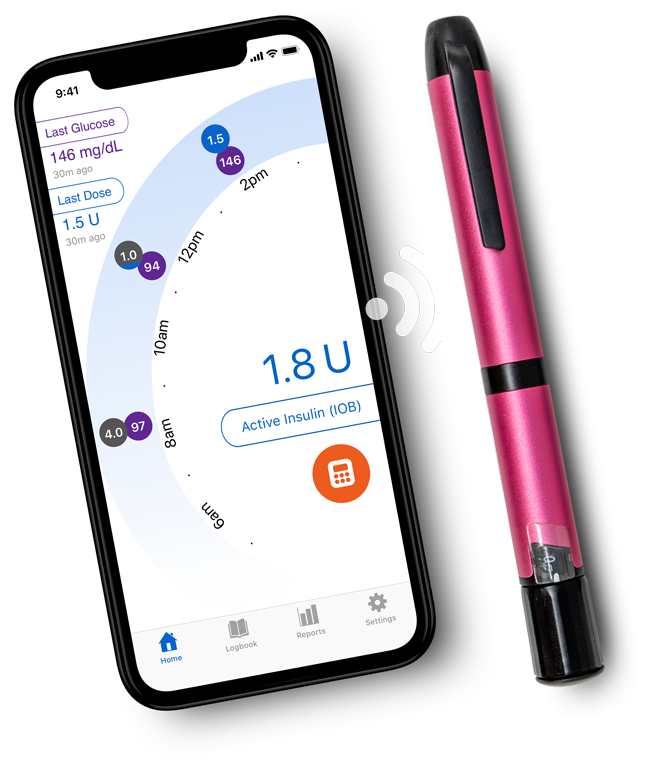Insulin Pens and Smart Pens
What is an Insulin Pen?
Since hitting the diabetes market in 1985, insulin pens have been a convenient and discreet way for people with diabetes to administer insulin.
An insulin pen (or just "pen") is an insulin delivery system that generally looks like a large pen, uses an insulin cartridge rather than a vial, and uses disposable needles.
Pens are the predominant insulin delivery system in most of the world, except the United States, where syringes and insulin vials still dominate. Pens are made by Novo Nordisk, Eli Lilly, Disetronic, and Owen Mumford. Disetronic makes pens for other companies, including Sanofi.
Some pens use replaceable insulin cartridges, and some pens use a non-replaceable cartridge and are disposed of after use. All pens use replaceable needles. Most pens use special pen needles (see discussion below), which can be extremely short and thin. The Disetronic pen, however, uses the same syringe as their DTron insulin pump, which has a traditional syringe leuer lock needle.





Replaceable Cartridges
Pens with replaceable cartridges are made by Novo Nordisk, Owen Mumford, and Disetronic. (You may have an older pen, made by BD, but those pens aren't being manufactured any longer.)
Insulin cartridges for pens come in 3.0 ml and 1.5 ml sizes, with 3.0 being the predominant size. The 1.5 ml size is being phased out and availability may be limited. Insulin cartridges are made by Eli Lilly, Novo Nordisk, and Sanofi.
Pre-filled Pens
Pens that come with a prefilled insulin cartridge are thrown away when the insulin is used up. Pre-filled pens are sold by insulin makers Eli Lilly, Novo Nordisk, and Sanofi. Lilly only sells pre-filled pens which come with a variety of Lilly insulins, including Humalog, Regular, NPH, and various mixes, including Humalog mixes. Novo Nordisk sells both pre-filled pens and pens that take replaceable insulin cartridges with NovoLog and other Novo Nordisk insulins. Sanofi sells pre-filled pens with Lantus and other Sanofi insulins.
Pre-filled pens using pre-mixed insulin are usually marketed for use by people with type 2 diabetes. The fixed ratio of insulins does not provide the flexibility needed to accommodate varying food and exercise.
Pen Needles
Pen needles should be removed after each use to prevent air from entering the cartridge and to prevent insulin from leaking out. There are many different pen needles available, in varying lengths and diameters.
BD pen needles come in three lengths:
- 5mm and 8mm (31G), and 12.7mm (29G)
- Novo Nordisk pen needles, called NovoFine®, come in 6mm (31G) or 8mm (30G)
- Owen Mumford pen needles, called Unifine Pentips, come in four sizes: 6mm (30G), 8mm (30G), 8mm (29G), and 12mm (29G)
- Disetronic pen needles, called Penfine, come in four sizes: 6mm (31G), 8mm (31G), 10mm (29G), and 12mm (29G)
Dosing with an Insulin Pen
Using a pen is quite easy. Once the cartridge is loaded, you simply screw on a pen needle, prime, if needed to clear out any air in the cartridge, dial the desired dose, inject the needle, and press the button to deliver the insulin. If you use a pen with an insulin suspension, such as NPH or a premixed insulin, you will need to gently shake the pen to be sure the insulin is mixed prior to use. Pens are easy enough for kids to use, and are excellent for use at school or while out and about.
Pen needles should be removed after each use to prevent air from entering the cartridge and to prevent insulin from leaking out. There are many different pen needles available, in varying lengths and diameters (see above).
The smallest pen needles are very short and very thin and help minimize the discomfort of injection. Unlike syringes, pens need to be held in place for several seconds after the insulin is delivered to ensure that no insulin leaks out. Syringe users who switch to pens should pay close attention to the injection site and test their blood glucose often as they become accustomed to pen injections.
Dosing increments vary by pen, with some pens starting at 1/2 or 1 unit and allowing 1/2 unit dosing, while others dose in one or two unit increments. While pens offer injection convenience, they don't allow mixing of multiple insulins, so if you inject short and long acting insulin together (e.g., Humalog and Lantus), you'll double your number of injections.
Pens offer repeatability in dosing accuracy compared with syringes. Also, because dosing with a pen involves dialing a mechanical device and not looking at the side of a syringe, insulin users with reduced visual acuity can be assured of accurate dosing with a pen.
What Are Insulin Smart Pens?
Smart insulin pens are the next generation of insulin pens, taking advantage of precision dosing in conjunction with an app that can import glucose results, calculate recommended insulin doses, and also keep track of dosing history. Smart pens can also share digital data with healthcare providers and caregivers, in addition to the convenience of having insulin handy while on the go.
The cost of smart pens is significantly less than insulin pumps, making these devices more accessible to more people with diabetes.
Smart pens currently available or in development:


